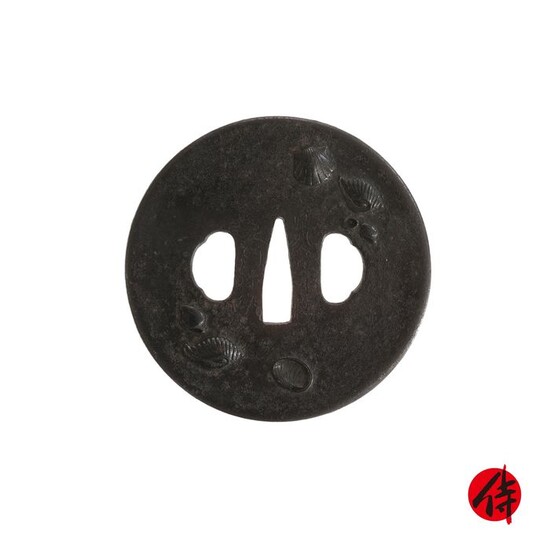Tsuba (1) - Cast iron - Sea Shells - Shoami - Antique Tsuba for Samurai Sword (T-181) - Japan - Edo Period (1600-1868)
Signature: Shoami An Iron Tsuba circle shape with Kozuka and Kougai holes This Tsuba is designed with a "Kai Dukushi" pattern. This pattern is a combination of various seashells. It's often designed with a seaside scene or wave pattern. Bivalves, especially clam, its shell cannot be combined with any other clam's shell; therefore, its design represents happy marriage. Shoami school worked as smiths for the Ashikaga Shogunate family. Shogun means the top of Samurai (Japanese soldier) , who ruled entire Japan. Mainly, they have two styles. The first pattern is circle-shaped iron Tsuba with openwork, and another type is with gold or silver inlaying. They were typically good at "Nunome Zougan"; it's a kind of inlay technique. Stripes, similar to textile design, are put on the metal and gold or silver leaf cut into these dents.
[ translate ]View it on
Estimate
Time, Location
Auction House
Signature: Shoami An Iron Tsuba circle shape with Kozuka and Kougai holes This Tsuba is designed with a "Kai Dukushi" pattern. This pattern is a combination of various seashells. It's often designed with a seaside scene or wave pattern. Bivalves, especially clam, its shell cannot be combined with any other clam's shell; therefore, its design represents happy marriage. Shoami school worked as smiths for the Ashikaga Shogunate family. Shogun means the top of Samurai (Japanese soldier) , who ruled entire Japan. Mainly, they have two styles. The first pattern is circle-shaped iron Tsuba with openwork, and another type is with gold or silver inlaying. They were typically good at "Nunome Zougan"; it's a kind of inlay technique. Stripes, similar to textile design, are put on the metal and gold or silver leaf cut into these dents.
[ translate ]


